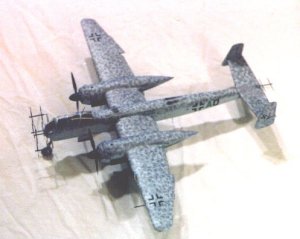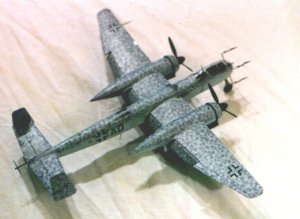

Tamiya 1/48 He-219A-7
Price: MSRP $45.00 - Bargains Are Available - Look Around
Medium: injection-molded plastic with white metal cockpit.
Decals: 3 different aircraft of NJG-1.
Accuracy: Dead on as far as every resource I have says. They made it from the He-219A-7 at the NASM.
Overall Quality: AAAAA+++++!!!
Reviewer: Thomas McKelvey Cleaver (The Aeronut)


Anybody who's interested in this airplane knows its history. All I can say is Erhard Milch has to be the narrowest-minded most petty bureaucrat to ever rise to any position of power anywhere, to fight the production and deployment of this airplane as he did.
The He-219 has been at or very close to the top of every "Most Wanted In 1/48" survey list ever drawn up. Going through some old magazines, I saw that one of the first of these lists with this airplane at #1 was 25 years ago in "Air Enthusiast." I'm glad we waited until this Golden Age Of Modelling we now live in for this model to be produced.
The kit goes together so well that an average modeller who takes care with it will end up with a result that looks like the work of an expert. Everything fits, except the little thingie on the main undercarriage over the tires. It's going to break because it's molded too narrow to go around the attachment point as it should. Save yourself the grief and just cut it in half to begin with and fix it from there. That is the only nit I have to pick with this model.
What is most brilliant here, a real example of lateral thinking, is the inclusion of the cockpit floot/nose gear well roof/rear bulkhead in white metal. With a cockpit right there in the extreme nose and main gear well forward of the halfway point of the fuselage, the He-219 previously was an exercise in frustration to make it nose-sit. This one wants to nose-sit!
The cockpit gives adequate detail, with room for super-detailers to go nuts as they wish. The cockpit glass is clear and you can close it up if you want and still see what's there. I did not assemble the step, because Tamiya didn't open the fuselage there, as it should be. If you do it, it's no problem to open it up as needed, and then you can hang the canopy open. As I understand it, it tilts 90 degrees, and there were no bungees or anything else holding it. My only step beyond doing this kit out of the box was to use some True Details German seatbelts in the cockpit.
The radar antennas are finely done, but be very, very careful cutting them off the sprue. No matter how careful you are, you will most likely bend them. It's no problem to straighten them, but it's something to bear in mind. This is a function of how finely molded they are.
The flaps fit just right. I have heard other modellers express doubt, but these were slotted flaps, and they're just fine. Assemble them according to the instructions. You are given the choice of having the cooling flaps open or closed. I chose open, but I think if I were doing it again I would close them because you see too much of too little inside the cowl with them open.
This kit assembles so easily that, once I had the cockpit painted and assembled, I had the basic airframe together and waiting to dry overnight within 2 hours. I admit I'm usually fast, but that was a world's record without even thinking about it.
Painting and camouflage: German nightfighters are pretty simple: 75 grauviolett and 76 hellblau. One of the versions the kit provides, the one on the cover, has undersides in semi-gloss black, but it didn't appeal to me. One thing I have always had a problem with in camouflaging the He-219 was that "dotting" the 76 with 75 never gave it that "cloudy" look all the photos show. Thank God for the Internet and r.m.s.!! Craig Chidley, who runs the Luftwaffe SIG site for IPMS Queensland Australia, put a post on r.m.s. (It's titled "HE-219 KIT REVIEW - LONG," dated November 23 1997 or so. I suggest you download it from DejaNews, it's really useful instruction-wise.) Anyway, he said he had painted the uppers completely in 75, and then "scribbled" over it in 76. The light went on! I looked at photos, and by golly, that's why the camouflage looks the way it does. I did it that way, pretending to be four Unteroffizieren with spray guns, one at nose, one at tail, one on either wing, each with his own way of "scribbling." You have to look closely, but there is a difference, and I think it adds a certain realism. So far as how far down the side of the fuselage this comes, it seems from the photos I've looked at to vary from aircraft to aircraft, so if you're a stickler for accuracy, check your photo references for the one you're doing.
Decals: Tamiya gives you the "England Blitz" insignia of NJG-1, but all the Luftwaffe meisters seem to agree the aircraft never had that. I left it off, bowing to the opinions of those who have dedicated their lives that the World War 2 Luftwaffe shall never die. I also changed the yellow code letter to a green one out of the decal box, because everything I've read says the Stab of NJG-1 used the He-219 most, and green would have been their color. Beyond that, it's pretty hard to do more than an anonymous nightfighter, though I bet Aeromaster will have "aces airplanes" out soon. Maybe they will be, maybe not.
Overall, this model is so good, it makes this butt-ugly nightfighter look pretty. I had a blast making it, it knocks out everybody who's seen it, and I don't think one can ask for more. In a year that has seen us given beautiful, crisp, accurate SBD Dauntlesses, SB2C Helldivers, Beaufighters, and Stormoviks - kits I have wanted for years and am happy as the proverbial clam to have - the He-219 tops them all for overall quality. This kit gets The Aeronut's Award for Kit Of The Year.
Copyright ModelingMadness.com. All rights reserved. No reproduction in part or in whole without express permission.